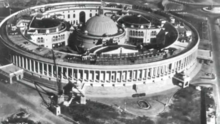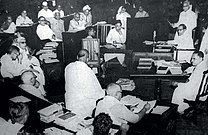Old Parliament House, New Delhi
| Parliament House | |
|---|---|
Sansad Bhavan | |
| File:Indian Parliament.svg Official logo | |
 Parliament House, seen from Rajpath | |
| Former names | House of Parliament |
| Alternative names | Parliament Buildings |
| General information | |
| Status | Functioning |
| Architectural style | Lutyens' Delhi |
| Address | Sansad Marg, New Delhi, India |
| Town or city | New Delhi |
| Country | |
| Coordinates | 28°37′02″N 77°12′29″E / 28.6172°N 77.2081°E |
| Construction started | 1921 |
| Opened | 1927 |
| Owner | British India (1927–1947) Government of India (1950–present) |
| Design and construction | |
| Architect(s) | Sir Edwin Lutyens and Sir Herbert Baker |
| Other information | |
| Seating capacity | 790 |
The Parliament House (IAST: Sansad Bhavan) in New Delhi is the seat of the Parliament of India. Its houses the Lok Sabha and the Rajya Sabha which represent lower and upper houses respectively in India's bicameral parliament.
At a distance of 750 meters from the Rashtrapati Bhavan, it is located on Sansad Marg which crosses the Central Vista and is surrounded by the Vijay Chowk, India Gate(All India War Memorial), National War Memorial (India), Vice President's House, Hyderabad House, Secretariat Building, Prime minister's office and residence, ministerial buildings and other administrative units of Indian government.
The building was designed by the British architects Edwin Lutyens and Herbert Baker and was constructed between 1921 and 1927. It was opened in January 1927 as the seat of the Imperial Legislative Council. Following the end of British rule in India, it was taken over by the Constituent Assembly, and then by the Indian Parliament once India's Constitution came into force in 1950.[1]
A new building to house Parliament is under construction directly opposite the current building as part of the Indian government's Central Vista Redevelopment Project.
History

Originally called the House of Parliament, it was designed by the British architects Edwin Lutyens and Herbert Baker in 1912-1913 as part of their wider mandate to construct a new administrative capital city for India. Construction of the Parliament House began in 1921 and it was completed in 1927.
The foundation stone was laid by HRH Prince Arthur, Duke of Connaught and Strathearn, in February 1921. It took five years to complete the building. On 18 January 1927, Sir Bhupendra Nath Mitra, Member of the Governor-General's Executive Council, in charge of the Department of Industries and Labour, invited Lord Irwin Viceroy of India to open the building. The third session of Central Legislative Assembly was held in this house on 19 January 1927.[2][3]
Two floors were added to the structure in 1956 due to a demand for more space.[4]
The Parliament Museum, opened in 2006, stands next to the Parliament House in the building of the Parliamentary Library.
Description
The perimeter of the building is circular, with 144 columns on the outside. At the centre of the building is the circular Central Chamber, and surrounding this Chamber are three semicircular halls that were constructed for the sessions of the Chamber of Princes (now used as the Library Hall), the State Council (now used for the Rajya Sabha), and the Central Legislative Assembly (now used for the Lok Sabha). The parliament is surrounded by large gardens and the perimeter is fenced off by sandstone railings (jali).[5]
Some sources speculate that the design of the building was inspired by the Chausath Yogini temple in Morena.[6]
The current building is planned to be converted into a Museum of Democracy after the new Parliament House is operational.[7]
Parliament House (New)
Background
Proposals for a new parliament building to replace Parliament House emerged in the early 2010s as a result of questions being asked about the stability of the original structure.[8] In 2012, a committee was assembled by the then-Speaker, Mira Kumar, to suggest and assess several alternatives to the usage of the building.[9]
Commencement
In 2019, the Indian government launched the Central Vista Redevelopment Project, a multi-billion dollar project to redevelop the Central Vista, India's central administrative area near Raisina Hill, New Delhi. The construction of a new parliament building, as well as redeveloping the Rajpath will create a new office and residence for the Indian prime minister, as well as combining all ministerial buildings in a single central secretariat.[10]
The groundbreaking ceremony for the new building was held in October 2020 and the foundation stone was laid on 10 December 2020.[11][12]
Incidents
2001 terror attack
The 2001 Indian Parliament attack was a terrorist attack on the Parliament of India in New Delhi, India on 13 December 2001. The perpetrators belonged to Lashkar-e-Taiba (LeT) and Jaish-e-Mohammed (JeM) - two Pakistan-raised terrorist organisations.[1][3] The attack led to the deaths of six Delhi Police personnel, two Parliament Security Service personnel, and a gardener – in total 9 – and led to increased tensions between India and Pakistan, resulting in the 2001–02 India–Pakistan standoff. The 5 terrorists were killed outside the parliament.[13]
Gallery
-
A Constituent Assembly of India meeting in 1950.
-
Jawaharlal Nehru addressing the constituent assembly in 1946.
-
Indian Prime Minister Morarji Desai listens to U.S President Jimmy Carter as he addresses the Indian Parliament House in 1978.
-
U.S President Barack Obama addressing Joint Session of the Parliament in 2010.
See also
References
- ^ Anisha Dutta (31 January 2020). "New Parliament complex may seat 1,350 members". Retrieved 1 February 2020.
- ^ "History of the Parliament of Delhi". delhiassembly.nic.in. Retrieved 13 December 2013.
- ^ Chopra, Prabha (1976). "Delhi Gazetteer".
- ^ Patel, Shivam; Lakhani, Somya (24 January 2020). "Diversity, efficiency, flexibility: The brief for redeveloping New Delhi's Central Vista". The Indian Express. Retrieved 5 January 2021.
- ^ "Parliament House: 144 pillars of pride". Hindustan Times. 7 June 2011. Retrieved 20 August 2018.
- ^ Bapat, Arun (9 August 2012). "Government should have confidence in this House". The Hindu. ISSN 0971-751X. Retrieved 5 March 2021.
- ^ "Construction of new Parliament building: Shaping the Central Vista". The Financial Express. 16 January 2021. Retrieved 16 January 2021.
- ^ "Delhi may see a new Parliament building". The Times of India. 13 July 2012. Archived from the original on 15 July 2012. Retrieved 13 December 2013.
- ^ Firstpost (13 July 2012). "Speaker sets up panel to suggest new home for Parliament". Firstpost. Retrieved 15 August 2012.
- ^ "Central Vista Redevelopment Project". Drishti IAS. 23 April 2020. Retrieved 22 September 2020.
- ^ PTI (1 October 2020). "Groundwork For New Parliament Building Begins, To Be Completed In 22 Months". BloombergQuint. Retrieved 6 March 2021.
- ^ Mathew, Liz (6 December 2020). "PM Modi to lay foundation stone for new Parliament building on December 10". The Indian Express. New Delhi. Retrieved 6 December 2020.
- ^ "Terrorists attack Parliament; five intruders, six cops killed". rediff.com. 13 December 2001. Retrieved 13 December 2013.
External links
 Media related to Sansad Bhavan at Wikimedia Commons
Media related to Sansad Bhavan at Wikimedia Commons






